Response to the COVID-19 Pandemic in Classrooms at the University of the Basque Country through a User-Informed Natural Ventilation Demonstrator
Abstract
1. Introduction
1.1. Ventilation in Educational Buildings in Europe, Spain and the Basque Country
- 81% of the studied samples ventilated just by means of opening and closing windows.
- Out of the buildings with mechanical ventilation systems, only 47% were equipped with an air quality control system that used CO2 concentration as a metric.
- 88% of the classrooms performed some ventilation action during breaks between lessons, while 70% kept the windows opened during classes also.
- Outdoor fresh air supply should be increased.
- Occupancy should be limited in areas where ventilation cannot be substantially increased.
- Air supply filtration with high-efficiency (HEPA) filters should be used.
- Substantially decrease, eliminate or dilute air recirculation in mechanical ventilation systems.
1.2. CO2 Concentration and SARS-CoV-2 Infection Prevention Protocols
2. Materials and Methods
2.1. Description of the Case Study
2.2. Monitoring and Real-Time Information System
- Temperature, T: 0 to 55 ± 0.5 °C, with a resolution of 0.1 °C
- Relative Humidity, R.H.: 1 to 95 ± 5% at 50% relative humidity
- CO2 concentration, CO2: 0 to 9999 ppm ± (50 ppm + 5% of reading)
2.2.1. Framework for Data Analysis
2.2.2. Phases for Analysis
2.3. Model for Retrospective Analysis of SARS-CoV-2
3. Results
3.1. Results for Phases I and II
3.1.1. Phase I
3.1.2. Phase II
3.1.3. Phase III
3.2. Comparative Analysis
3.2.1. Classrooms A 1.1 and A 2.1
- In classroom A 1.1, from 82.8% of the time with CO2 levels below 900 ppm in Phase I to 80.6% in Phase II, reaching 98.3% in Phase II-b (spring).
- In classroom A 2.1, from 89.4% of the time with CO2 levels below 900 ppm in Phase I to 83.3% in Phase II-a, reaching 100% in Phase II-b (spring).
- In classroom A 1.1, from less than 1% of the time with thermal comfort within winter limits in Phase I to 21.7% in Phase II-a, reaching 38.3% in Phase II-b (spring).
- In classroom 2.1, from around 7% of the time with a thermal comfort within winter ranges in Phase I to 27.8% in Phase II-a, but only 3.3% in Phase II-b (spring).
- Classroom A 1.1 rose from 18.3% of the time with thermal comfort within the winter conditions in Phase I to 78.9% in Phase II-a and more than 91% in Phase II-b (spring).
- In classroom A 2.1, from 42.8% of the time with thermal comfort within winter ranges in Phase I to 88.3% in Phase II-a, dropping to 40% in Phase II-b (spring).
3.2.2. Administration Office
- Data show an improvement from 87.6% of the time with CO2 levels below 900 ppm in Phase I to 100% in Phase II, dropping slightly to 98.1% in Phase III (summer).
- There was an evolution from 16.3% of the time within RITE acceptable ranges in comfort for winter in Phase I to 31% in Phase II; however, in Phase III, with different limits for comfort, values within the ranges (summer) were not obtained due to an excess of humidity and temperature.
- A rise from 44.2% of the time within INSST thermal comfort ranges in Phase I to 76.7% in Phase II-a, dropping to 68.6% in Phase III due to the aforementioned reasons.
3.3. Retrospective Analysis of SARS-CoV-2
- For a 0.72 q/h emission rate, the accumulated P during at the end of the week was 0.0645 or 6.45%.
- For a quanta emission rate of 1 q/h, P was 0.0896 or around 9%
- For q = 1.70 q/h, the total-week secondary spread risk reached 15.23%
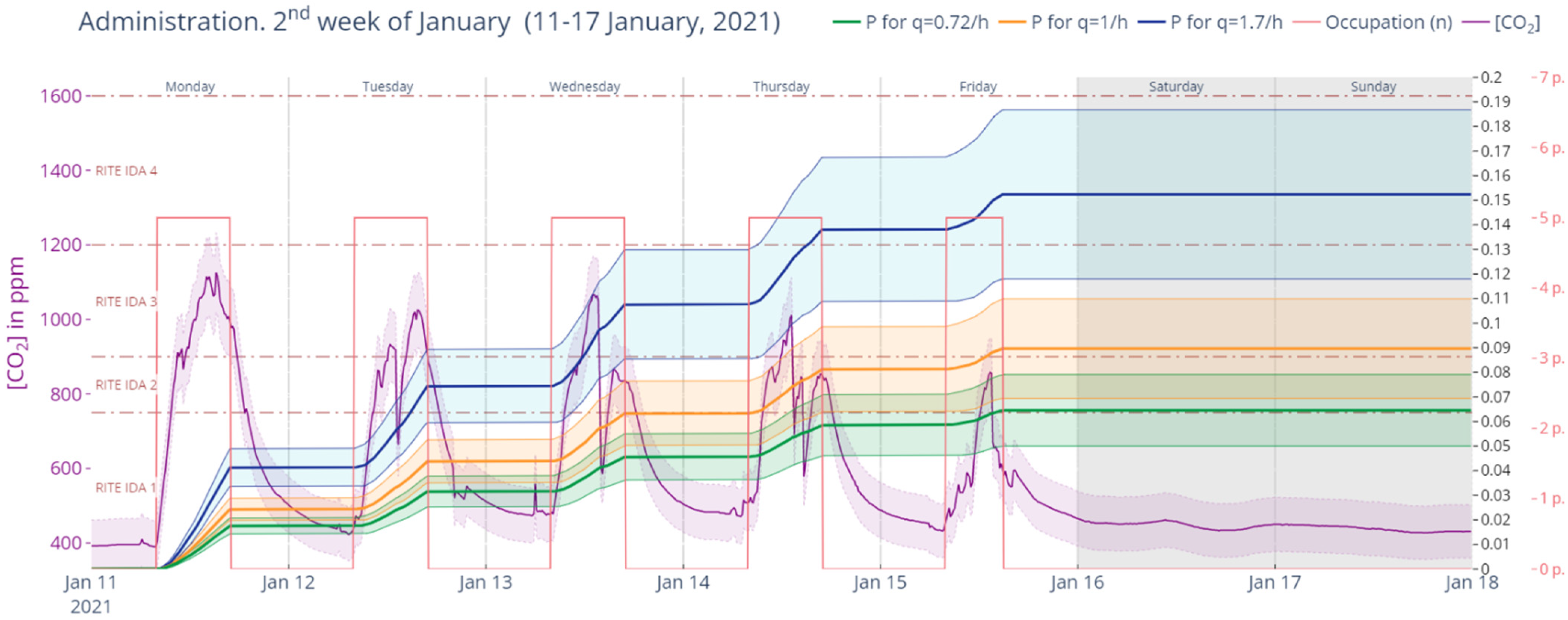
4. Conclusions
Author Contributions
Funding
Institutional Review Board Statement
Informed Consent Statement
Data Availability Statement
Acknowledgments
Conflicts of Interest
References
- SAV Systems, Decarbonizing UK School Ventilation, Surrey. 2020. Available online: https://czone.eastsussex.gov.uk/media/1954/gil147-schools-energy-saving-fact-sheet.pdf (accessed on 25 August 2022).
- Ye, Y.; Chen, Y.; Zhang, J.; Pang, Z.; O’Neill, Z.; Dong, B.; Cheng, H. Energy-saving potential evaluation for primary schools with occupant-centric controls. Appl. Energy 2021, 293, 116854. [Google Scholar] [CrossRef]
- Park, K.Y.; Woo, D.O.; Leigh, S.B.; Junghans, L. Impact of Hybrid Ventilation Strategies in Energy Savings of Buildings: In Regard to Mixed-Humid Climate Regions. Energies 2022, 15, 1960. [Google Scholar] [CrossRef]
- Stasi, R.; Ruggiero, F.; Berardi, U. The efficiency of hybrid ventilation on cooling energy savings in NZEBs. J. Build. Eng. 2022, 53, 104401. [Google Scholar] [CrossRef]
- Gomis, L.L.; Fiorentini, M.; Daly, D. Potential and practical management of hybrid ventilation in buildings. Energy Build. 2021, 231, 110597. [Google Scholar] [CrossRef]
- Stafford, T.M. Indoor air quality and academic performance. J. Environ. Econ. Manag. 2015, 70, 34–50. [Google Scholar] [CrossRef]
- Bakó-Biró, Z.; Clements-Croome, D.J.; Kochhar, N.; Awbi, H.B.; Williams, M.J. Ventilation rates in schools and pupils’ performance. Build. Environ. 2012, 48, 215–223. [Google Scholar] [CrossRef]
- Szabados, M.; Csákó, Z.; Kotlík, B.; Kazmarová, H.; Kozajda, A.; Jutraz, A.; Kukec, A.; Otorepec, P.; Dongiovanni, A.; di Maggio, A.; et al. Indoor air quality and the associated health risk in primary school buildings in Central Europe—The InAirQ study. Indoor Air 2021, 31, 989–1003. [Google Scholar] [CrossRef]
- Fisk, W.J.; Chan, W.R.; Johnson, A.L. Does dampness and mold in schools affect health? Results of a meta-analysis. Indoor Air 2019, 29, 895–902. [Google Scholar] [CrossRef]
- Holst, G.J.; Høst, A.; Doekes, G.; Meyer, H.W.; Madsen, A.M.; Plesner, K.B.; Sigsgaard, T. Allergy and respiratory health effects of dampness and dampness-related agents in schools and homes: A cross-sectional study in Danish pupils. Indoor Air 2016, 26, 880–891. [Google Scholar] [CrossRef]
- Toyran, M.; Yagmur, I.T.; Guvenir, H.; Haci, I.A.; Bahceci, S.; Batmaz, S.B.; Topal, O.Y.; Celik, I.K.; Karaatmaca, B.; Misirlioglu, E.D.; et al. Asthma control affects school absence, achievement and quality of school life: A multicenter study. Allergol. Immunopathol. 2020, 48, 545–552. [Google Scholar] [CrossRef]
- Environmental Protection Agency (EPA). Student Health and Academic Performance—Quick Reference Guide November 2012, Washington DC. 2012. Available online: https://www.epa.gov/sites/default/files/2014-08/documents/student_performance_findings.pdf (accessed on 25 August 2022).
- Mondragon, N.I.; Sancho, N.B.; Santamaria, M.D.; Ozamiz-Etxebarria, N. Reopening of Schools in the COVID-19 Pandemic: The Quality of Life of Teachers While Coping with This New Challenge in the North of Spain. Int. J. Environ. Res. Public Health 2021, 18, 7791. [Google Scholar] [CrossRef] [PubMed]
- ¿Qué es Campus Bizia Lab?—Sostenibilidad—UPV/EHU, University of the Basque Country. (n.d.). Available online: https://www.ehu.eus/es/web/iraunkortasuna/campus-bizia-lab-zer-da (accessed on 25 August 2022).
- Rodriguez-Vidal, I.; Oregi, X.; Otaegi, J.; Vallespir-Etxebarria, G.; Millán-García, J.A.; Martín-Garín, A. Integration of Indoor Air Quality Concerns in Educational Community through Collaborative Framework of Campus Bizia Laboratory of the University of the Basque Country. In Smart and Sustainable Technology for Resilient Cities and Communities; Springer: Singapore, 2022; pp. 73–88. [Google Scholar] [CrossRef]
- Otaegi, J.; Rodríguez-Vidal, I.; Martín-Garín, A. Proyecto piloto sobre la calidad del aire en espacios interiores universitarios: Implementación en el TFM “Nekazaritza Eskola Jaizubian” del Máster Universitario en Arquitectura, San Sebastián. 2021. Available online: https://www.ehu.eus/documents/4736101/30212116/Jorge-Otaegi_Nekazaritza-Eskola-Jaizubian.pdf (accessed on 25 August 2022).
- Taştan, M.; Gökozan, H. Real-Time Monitoring of Indoor Air Quality with Internet of Things-Based E-Nose. Appl. Sci. 2019, 9, 3435. [Google Scholar] [CrossRef]
- Ha, Q.P.; Metia, S.; Phung, M.D. Sensing Data Fusion for Enhanced Indoor Air Quality Monitoring. IEEE Sens. J. 2020, 20, 4430–4441. [Google Scholar] [CrossRef]
- Pradityo, F.; Surantha, N. Indoor Air Quality Monitoring System with Fuzzy Logic Control Based On IOT. Int. J. Sci. Technol. Res. 2019, 8, 8. Available online: www.ijstr.org (accessed on 30 October 2022).
- Kanal, A.K.; Kovacshazy, T. IoT solution for assessing the indoor air quality of educational facilities. In Proceedings of the 2019 20th International Carpathian Control Conference, ICCC 2019, Krakow-Wieliczka, Poland, 26–29 May 2019. [Google Scholar] [CrossRef]
- Saini, J.; Dutta, M.; Marques, G. Indoor Air Quality Monitoring Systems Based on Internet of Things: A Systematic Review. Int. J. Environ. Res. Public Health 2020, 17, 4942. [Google Scholar] [CrossRef] [PubMed]
- Snow, S.; Danam, R.; Leardini, P.; Glencross, M.; Beeson, B.; Ottenhaus, L.M.; Boden, M. Human factors affecting ventilation in Australian classrooms during the COVID-19 pandemic: Toward insourcing occupants’ proficiency in ventilation management. Front. Comput. Sci. 2022, 4, 100. [Google Scholar] [CrossRef]
- Monge-Barrio, A.; Bes-Rastrollo, M.; Dorregaray-Oyaregui, S.; González-Martínez, P.; Martin-Calvo, N.; López-Hernández, D.; Arriazu-Ramos, A.; Sánchez-Ostiz, A. Encouraging natural ventilation to improve indoor environmental conditions at schools. Case studies in the north of Spain before and during COVID. Energy Build. 2022, 254, 111567. [Google Scholar] [CrossRef]
- Miranda, M.T.; Romero, P.; Valero-Amaro, V.; Arranz, J.I.; Montero, I. Ventilation conditions and their influence on thermal comfort in examination classrooms in times of COVID-19. A case study in a Spanish area with Mediterranean climate. Int. J. Hyg. Environ. Health 2022, 240, 113910. [Google Scholar] [CrossRef]
- Grupo Interministerial para la Redacción del ERESEE, ERESEE 2020. Actualización de 2020 de la Estrategia a Largo Plazo para la Rehabilitación Energética en el Sector de la Edificación en España, 1st ed.; Gobierno de España: Madrid, Spain, 2020; Available online: https://www.mitma.gob.es/recursos_mfom/paginabasica/recursos/es_ltrs_2020.pdf (accessed on 25 August 2022).
- Departamento de Educación. Gobierno Vasco—Euskadi.eus, (n.d.). Available online: https://www.euskadi.eus/gobierno-vasco/departamento-educacion/ (accessed on 25 August 2022).
- Ministerio de la Presidencia, Real Decreto 178/2021, de 23 de marzo, por el que se Modifica el Reglamento de Instalaciones Térmicas en los Edificios. Gobierno de España, Madrid. 2021. Available online: https://www.boe.es/boe/dias/2021/03/24/pdfs/BOE-A-2021-4572.pdf (accessed on 25 August 2022).
- Fernandez de la Vega Sanz, M.T. Real Decreto 1027/2007, de 20 de julio, por el que se aprueba el Reglamento de Instalaciones Térmicas en los Edificios., Ministerio de la Presidencia del Gobierno de España, Madrid, n.d. Available online: https://www.boe.es/boe/dias/2007/08/29/pdfs/A35931-35984.pdf (accessed on 25 August 2022).
- Cuerdo-Vilches, T. COVID-19: La Ventilación en Centros educativos, una Asignatura Pendiente, The Conversation. 2020. Available online: https://digital.csic.es/handle/10261/227119 (accessed on 25 August 2022).
- Arias-Salgado y Montalvo, R. Real Decreto 1618/1980, de 4 de julio, por el que se Aprueba el Reglamento de Instalaciones de Calefacción, Climatización y Agua Caliente Sanitaria, con el fin de Racionalizar su Consumo Energético. Ministerio de la Presidencia, Madrid. 1980. Available online: https://www.boe.es/buscar/doc.php?id=BOE-A-1980-16729 (accessed on 25 August 2022).
- Pérez-Llorca, J.P. Real Decreto 2429/1979, de 6 de julio, por el que se aprueba la norma básica de edificación NBE-CT-79, Sobre Condiciones Térmicas en los Edificios. Ministerio de la Presidencia del Gobierno de España, Madrid. 1979. Available online: https://www.boe.es/buscar/doc.php?id=BOE-A-1979-24866 (accessed on 30 October 2022).
- Csobod, E.; Annesi-Maesano, I.; Carrer, P.; Kephalopoulos, S.; Madureira, J.; Rudnai, P.; Fernandes, E.O.; Barrero, J.; Beregszaszi, T.; Hyvarrin, A.; et al. SINPHONIE—Schools Indoor Pollution and Health Observatory Network in Europe—Final Report; Publications Office of the European Union: Luxembourg, 2014. [Google Scholar] [CrossRef]
- Villalaín, J.M.M.; Cuevas, B.G. Proyecto de Monitorización de Colegios. Estudio Completo e Informe de Conclusions; PEP: Burgos, Spain, 2020. [Google Scholar]
- del Campo Díaz, V.J.; Martínez, A.M. Calidad del Aire Interior en los Centros de Educación Infantil del País Vasco, El Instalador; InterempresasMedia: Madrid, Spain, 2006; pp. 34–42. ISSN 0210-4091. Available online: https://dialnet.unirioja.es/servlet/articulo?codigo=1430370 (accessed on 25 August 2022).
- Kephalopoulos, S.; Csobod, E.; Bruinen De Bruin, Y.; de Oliveira Fernandes, E. Guidelines for Healthy Environments within European Schools; Publications Office of the European Union: Luxembourg, 2014. [Google Scholar] [CrossRef]
- REHVA. REHVA COVID-19 Guidance Document, 3 August 2020. Available online: https://www.rehva.eu/fileadmin/user_upload/REHVA_COVID-19_guidance_document_V3_03082020.pdf (accessed on 25 August 2022).
- REHVA. REHVA COVID-19 Guidance Document—v4 November 2020. 2020. Available online: https://www.rehva.eu/fileadmin/user_upload/REHVA_COVID-19_guidance_document_V4_23112020.pdf (accessed on 25 August 2022).
- Cuerdo-Vilches, T. Ventilación en Espacios Educativos. 2021. Available online: https://digital.csic.es/handle/10261/236622 (accessed on 25 August 2022).
- de Abajo, F.J.G.; Hernández, R.J.; Kaminer, I.; Meyerhans, A.; Rosell-Llompart, J.; Sanchez-Elsner, T. Back to Normal: An Old Physics Route to Reduce SARS-CoV-2 Transmission in Indoor Spaces. ACS Nano 2020, 14, 7704–7713. [Google Scholar] [CrossRef]
- Peng, Z.; Jimenez, J.L. Exhaled CO2 as a COVID-19 infection risk proxy for different indoor environments and activities. Environ. Sci. Technol. Lett. 2021, 8, 392–397. [Google Scholar] [CrossRef]
- Minguillón, M.C.; Querol, X.; Felisi, J.M.; Garrido, T. Guía Para Ventilación de las Aulas CSIC. 2020. Available online: http://hdl.handle.net/10261/221538 (accessed on 25 August 2022).
- EJ-GV, Guia Para Reducir el Riesgo de Transmisión del SARS-CoV-2 por Aerosoles en Centros Educativos, Vitoria-Gasteiz. 2020. Available online: https://www.euskadi.eus/contenidos/informacion/koronavirusa_coronavirus/es_def/adjuntos/guia_ventilacion_c.pdf (accessed on 25 August 2022).
- Schoen, L.J. Guidance for Building Operations during the COVID-19 Pandemic. ASHRAE J. 2020, 5, 3. [Google Scholar] [CrossRef]
- European Centre for Disease and Control, Heating, Ventilation and Air-Conditioning Systems in the Context of COVID-19: First Update. 2020. Available online: https://www.ecdc.europa.eu/sites/default/files/documents/Heating-ventilation-air-conditioning-systems-in-the-context-of-COVID-19-first-update.pdf (accessed on 25 August 2022).
- Morawska, L.; Tang, J.W.; Bahnfleth, W.; Bluyssen, P.M.; Boerstra, A.; Buonanno, G.; Cao, J.; Dancer, S.; Floto, A.; Franchimon, F.; et al. How can airborne transmission of COVID-19 indoors be minimised? Environ. Int. 2020, 142, 105832. [Google Scholar] [CrossRef] [PubMed]
- Bilbao Artetxe, L. UPV-EHU COVID-19 Guidance. Medidas Para el Funcionamiento de los Centros de la UPV/EHU Para el Curso Académico 2020–2021, Leioa. 2020. Available online: https://www.ehu.eus/documents/10136/25279943/Medidas+para+el+funcionamiento+2020-2021+%282021.05.31%29.pdf/ba41582b-6bd6-f8c2-8e0a-af56f9d18d18?t=1622627403678 (accessed on 25 August 2022).
- Rodríguez-Vidal, I.; Otaegi, J.; Oregi, X. Thermal Comfort in NZEB Collective Housing in Northern Spain. Sustainability 2020, 12, 9630. [Google Scholar] [CrossRef]
- ISO 7730:2005; Ergonomics of the Thermal Environment—Analytical Determination and Interpretation of Thermal Comfort Using Calculation of the PMV and PPD Indices and Local Thermal Comfort Criteria. ISO: Geneva, Switzerland, 2005. Available online: https://www.iso.org/standard/39155.html (accessed on 26 August 2022).
- Álvarez-Cascos Fernández, F. Real Decreto 1751/1998, de 31 de Julio, por el que se Aprueba el Reglamento de Instalaciones Térmicas en los Edificios (RITE) y sus Instrucciones Técnicas Complementarias (ITE). Ministerio de la Presidencia del Gobierno de España, Madrid. 1998. Available online: https://www.boe.es/boe/dias/1998/08/05/pdfs/A26585-26634.pdf (accessed on 26 August 2022).
- EN 16798-1:2019; Energy Performance of Buildings—Ventilation for Buildings—Part 1: Indoor Environmental Input Parameters for Design and Assessment of Energy Performance of Buildings Addressing Indoor Air Quality, Thermal Environment, Lighting and Acoustics. CEN: Brussels, Belgium, 2019. Available online: https://www.cen.eu/ (accessed on 26 August 2022).
- Trujillo Rincón, M.A. Real Decreto 314/2006, de 17 de Marzo, por el Que se Aprueba el Código Técnico de la Edificación., Ministerio de Vivienda del Gobierno de España, Madrid. 2006. Available online: https://www.boe.es/boe/dias/2006/03/28/pdfs/A11816-11831.pdf (accessed on 26 August 2022).
- Instituto Nacional de Seguridad y Salud en el Trabajo: Ambiente Térmico, (n.d.). Available online: https://www.insst.es/ambiente-termico (accessed on 26 August 2022).
- Tan, S.; Zhang, Z.; Maki, K.; Fidkowski, K.J.; Capecelatro, J. Beyond well-mixed: A simple probabilistic model of airborne disease transmission in indoor spaces. Indoor Air 2022, 32, e13015. [Google Scholar] [CrossRef]
- Mikszewski, A.; Stabile, L.; Buonanno, G.; Morawska, L. The airborne contagiousness of respiratory viruses: A comparative analysis and implications for mitigation. Geosci. Front. 2021, 13, 101285. [Google Scholar] [CrossRef]
- Fantozzi, F.; Lamberti, G.; Leccese, F.; Salvadori, G. Monitoring CO2 Concentration to Control the Infection Probability Due to Airborne Transmission in Naturally Ventilated University Classrooms. Archit. Sci. Rev. 2022, 2022, 306–318. [Google Scholar] [CrossRef]
- Zhao, X.; Liu, S.; Yin, Y.; Zhang, T.; Chen, Q. Airborne transmission of COVID-19 virus in enclosed spaces: An overview of research methods. Indoor Air 2022, 32, e13056. [Google Scholar] [CrossRef]
- Woodhouse, M.J.; Aspinall, W.P.; Sparks, R.S.J.; Brooks-Pollock, E.; Relton, C. Alternative COVID-19 mitigation measures in school classrooms: Analysis using an agent-based model of SARS-CoV-2 transmission. R. Soc. Open Sci. 2022, 9, 211985. [Google Scholar] [CrossRef]
- Lau, Z.; Griffiths, I.M.; English, A.; Kaouri, K. Predicting the spatio-Temporal infection risk in indoor spaces using an efficient airborne transmission model, Proceedings of the Royal Society A: Mathematical. Phys. Eng. Sci. 2022, 478, 20210383. [Google Scholar] [CrossRef]
- Corzo, S.F.; Ramajo, D.E.; Idelsohn, S.R. Study of ventilation and virus propagation in an urban bus induced by the HVAC and by opening of windows. Comput Methods Appl. Mech. Eng. 2022, 401, 115387. [Google Scholar] [CrossRef]
- Xu, C.; Wah, C.; Yu, F. Prevention and control of COVID-19 transmission in the indoor environment. Indoor and Built Environment 2022, 31, 1159–1160. [Google Scholar] [CrossRef]
- COVID-19 Ventilation Calculator V2.1, REHVA. Federation of European Heating, Ventilation and Air Conditioning Associations. (n.d.). Available online: https://www.rehva.eu/covid19-ventilation-calculator (accessed on 26 August 2022).
- REHVA. COVID-19 Ventilation Calculator Documentation. 2021. Available online: https://www.rehva.eu/fileadmin/content/documents/Downloadable_documents/REHVA_COVID-19_Ventilation_Calculator_user_guide_V2.0.pdf (accessed on 26 August 2022).
- Burridge, H.C.; Fan, S.; Jones, R.L.; Noakes, C.J.; Linden, P.F. Predictive and retrospective modelling of airborne infection risk using monitored carbon dioxide. Indoor Built. Environ. 2021, 31, 1363–1380. [Google Scholar] [CrossRef]
- Persily, A.; de Jonge, L. Carbon dioxide generation rates for building occupants. Indoor Air 2017, 27, 868–879. [Google Scholar] [CrossRef] [PubMed]
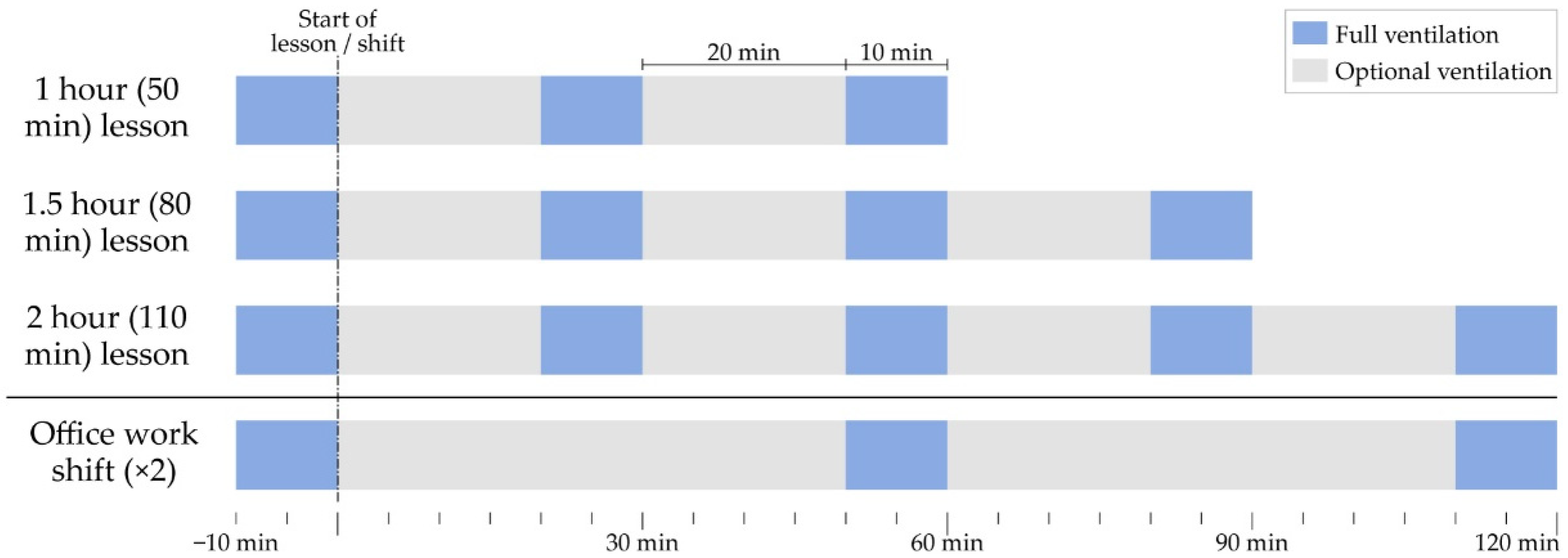

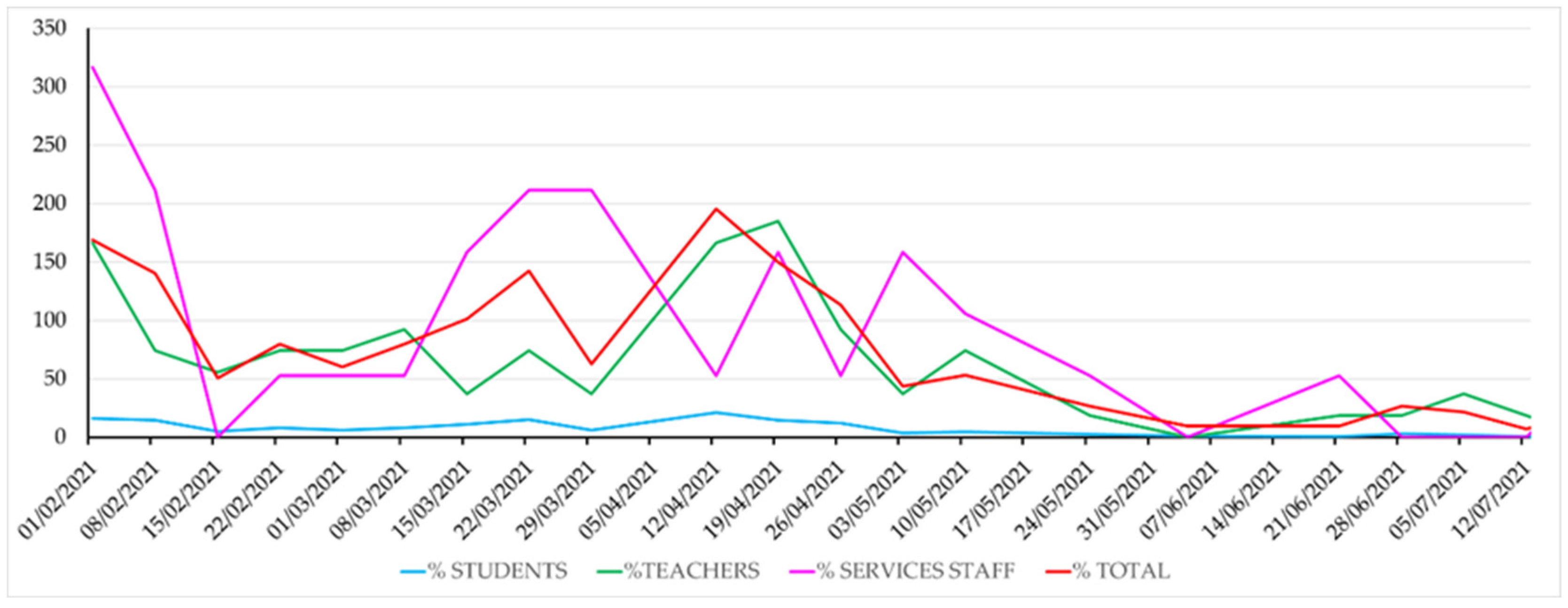
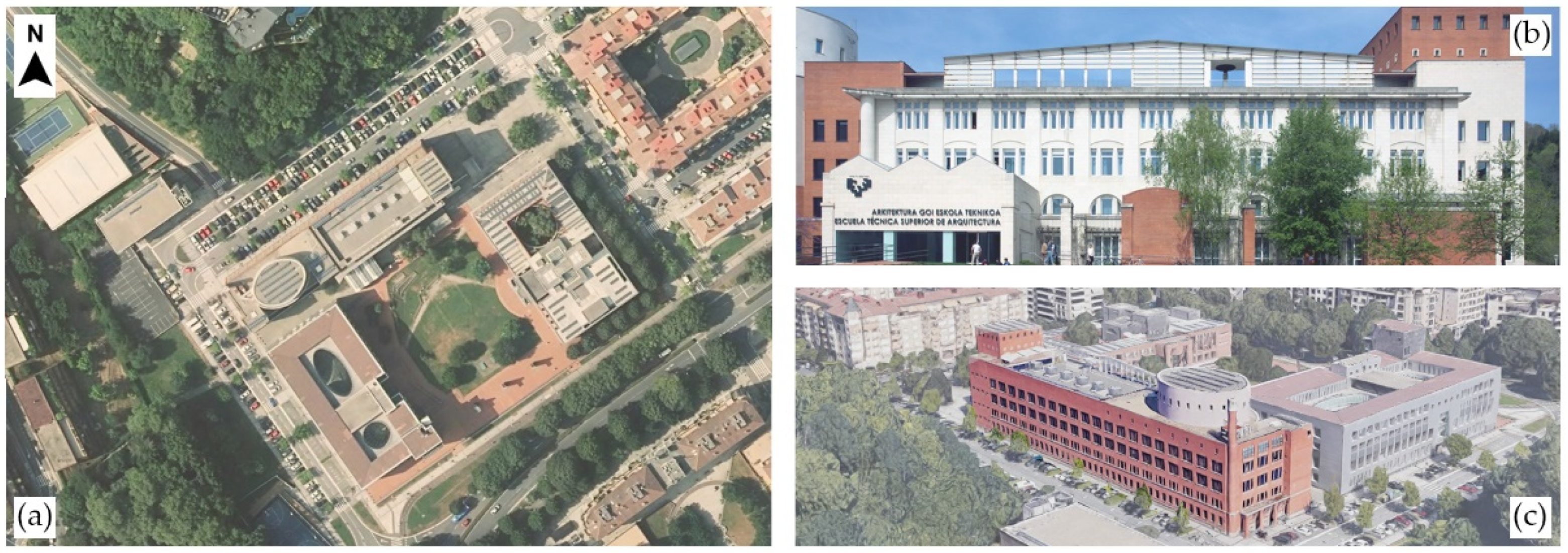
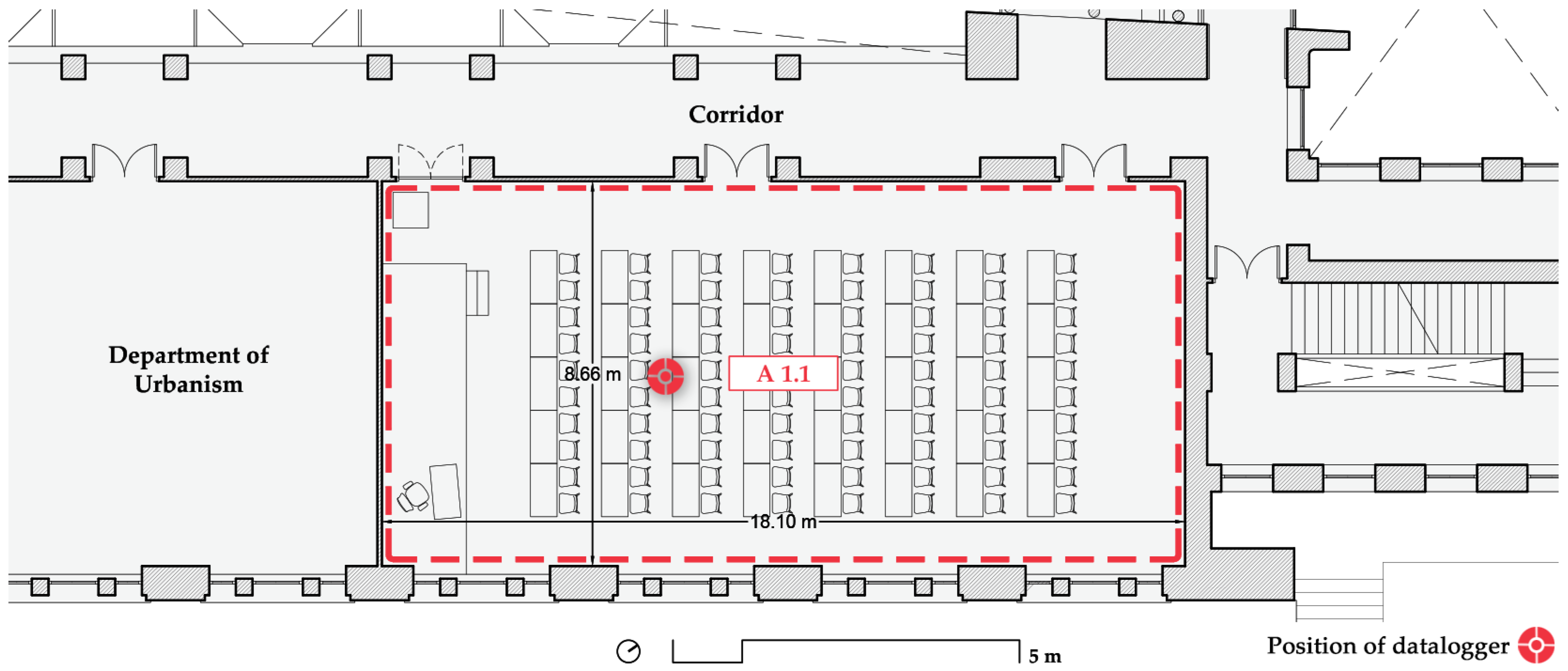
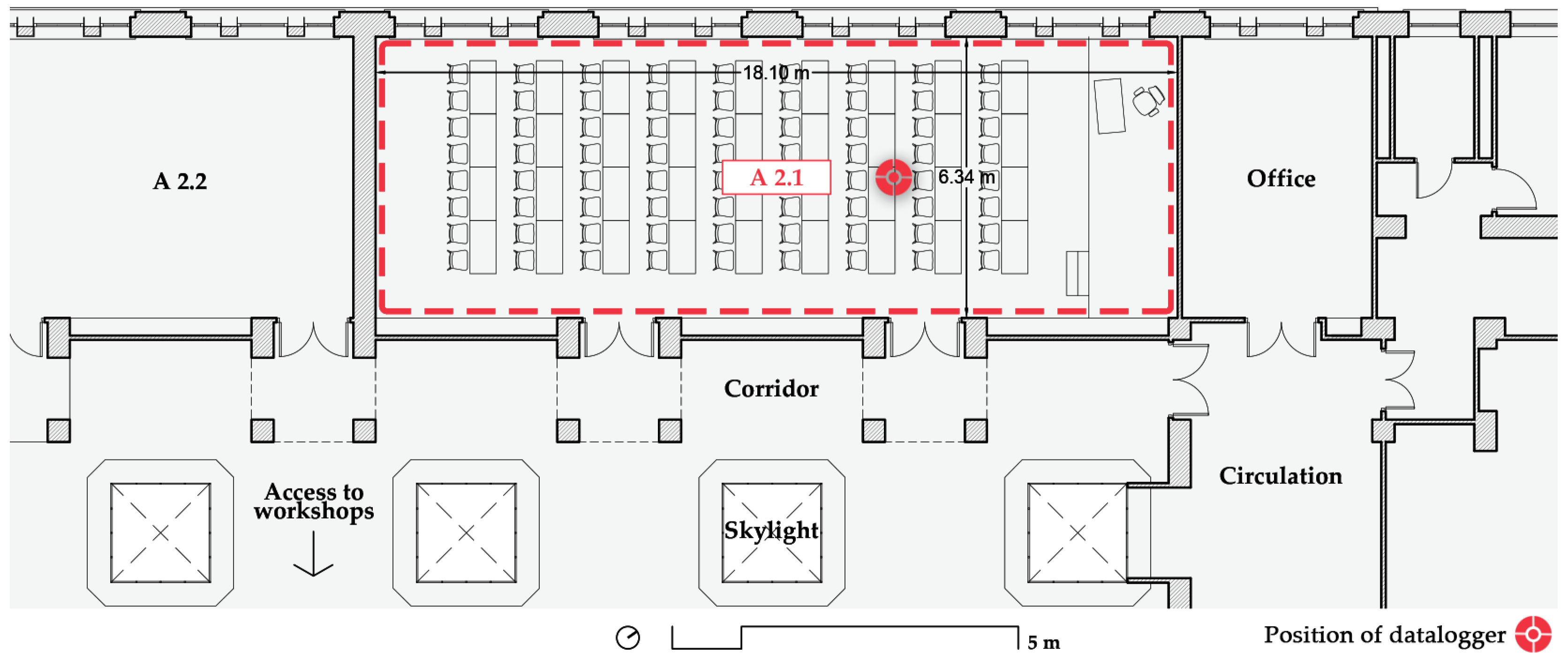
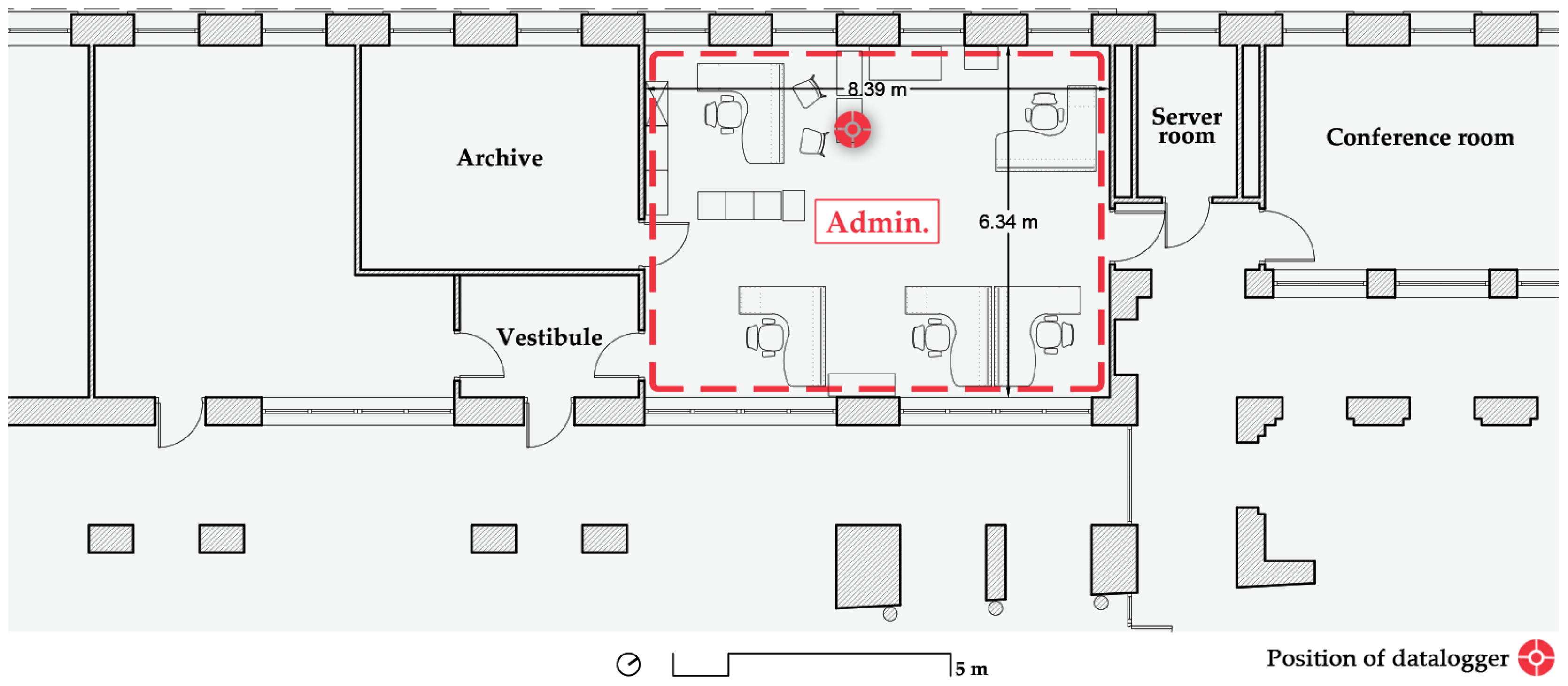

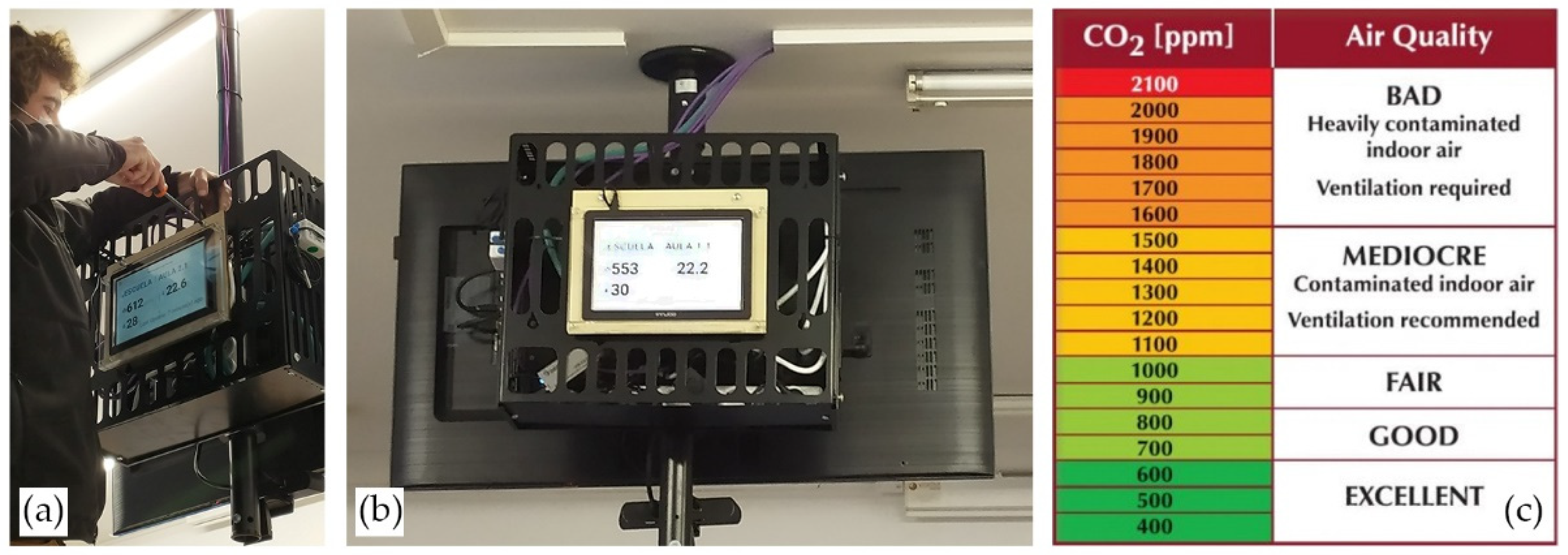

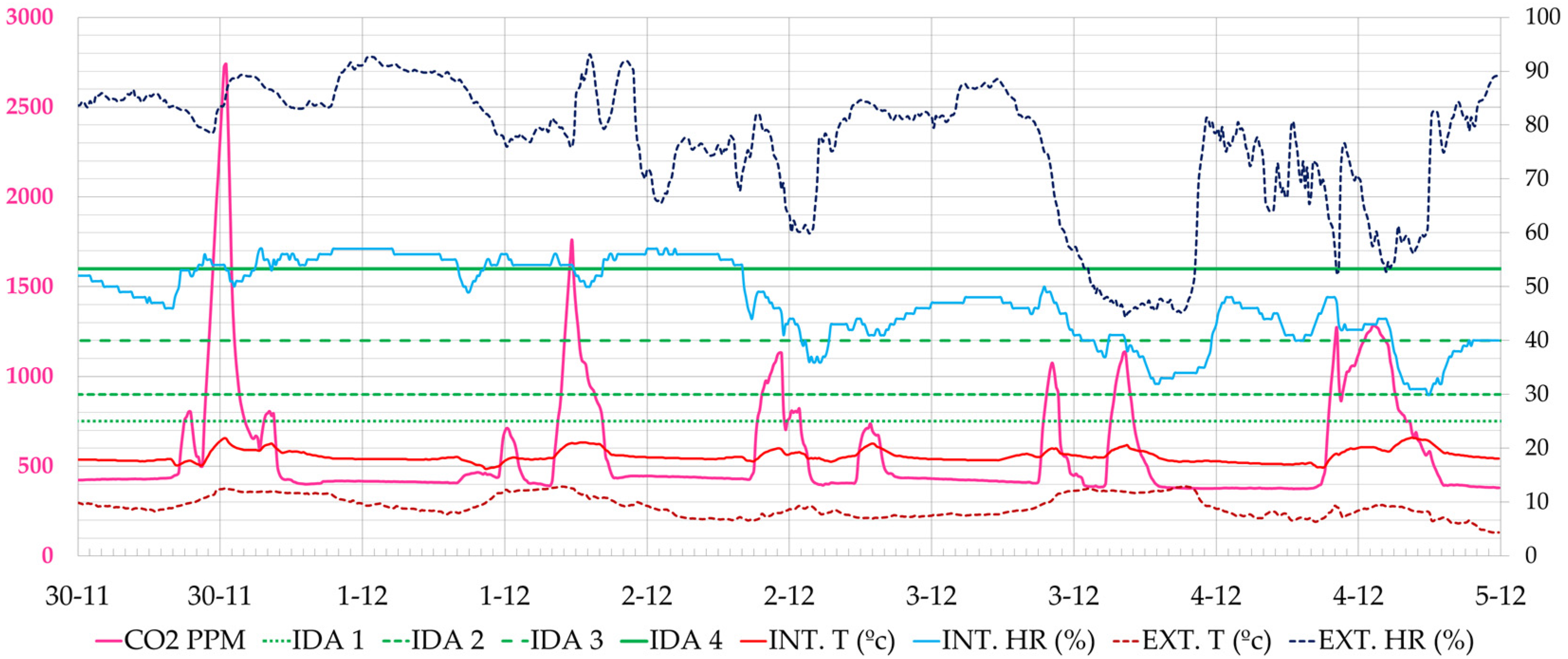

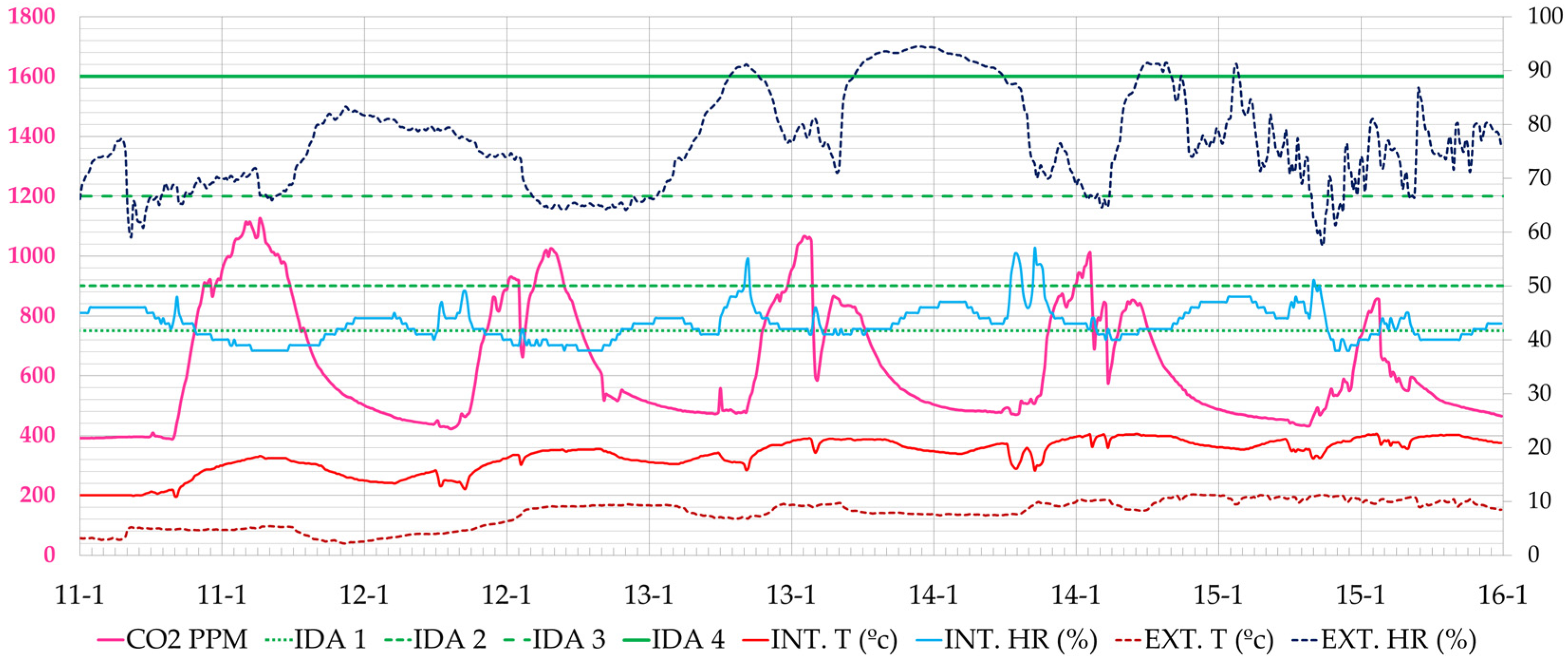
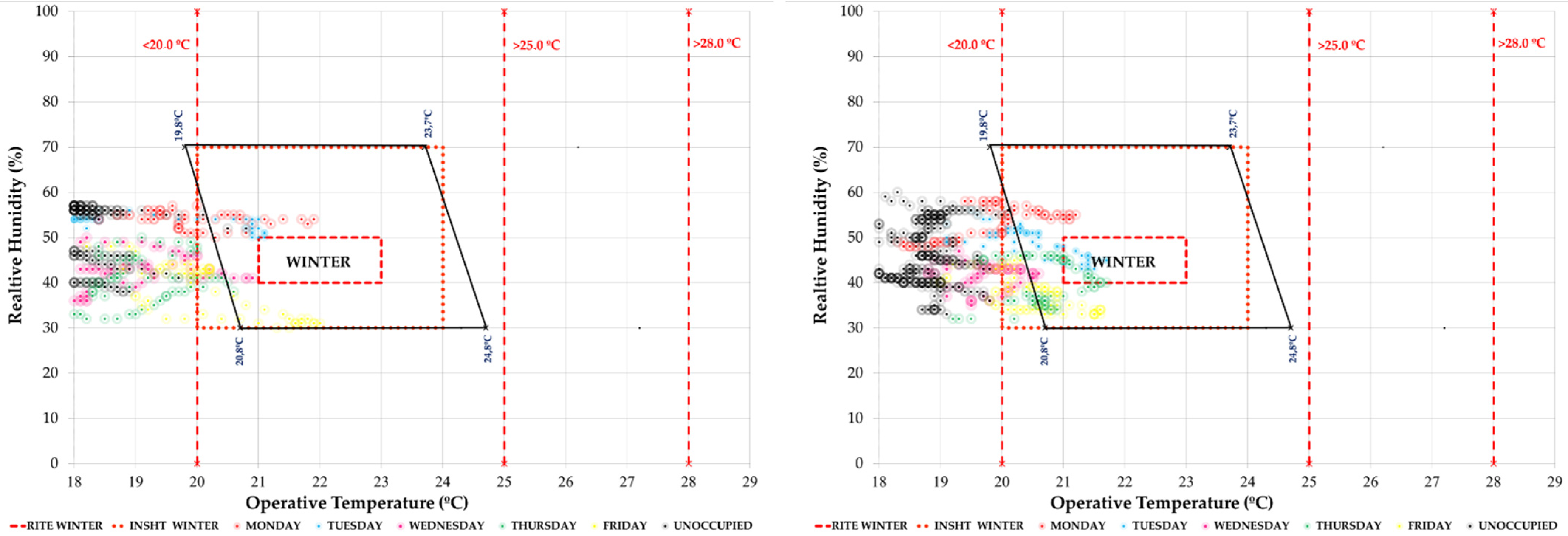
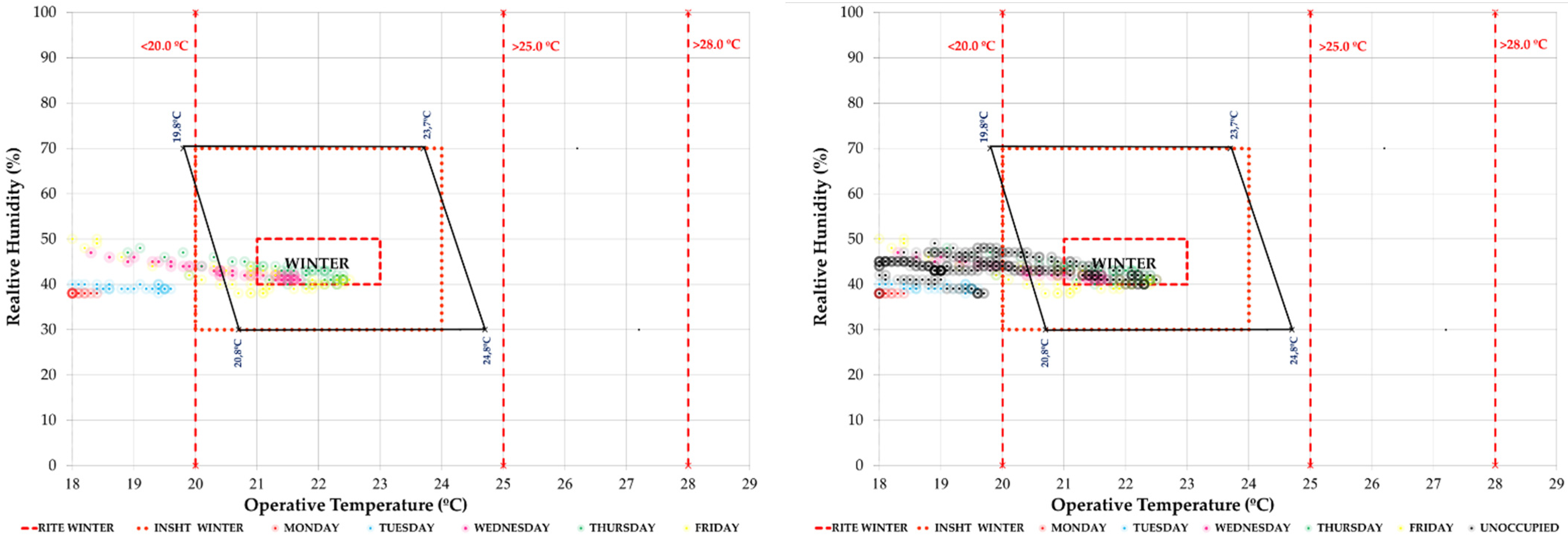

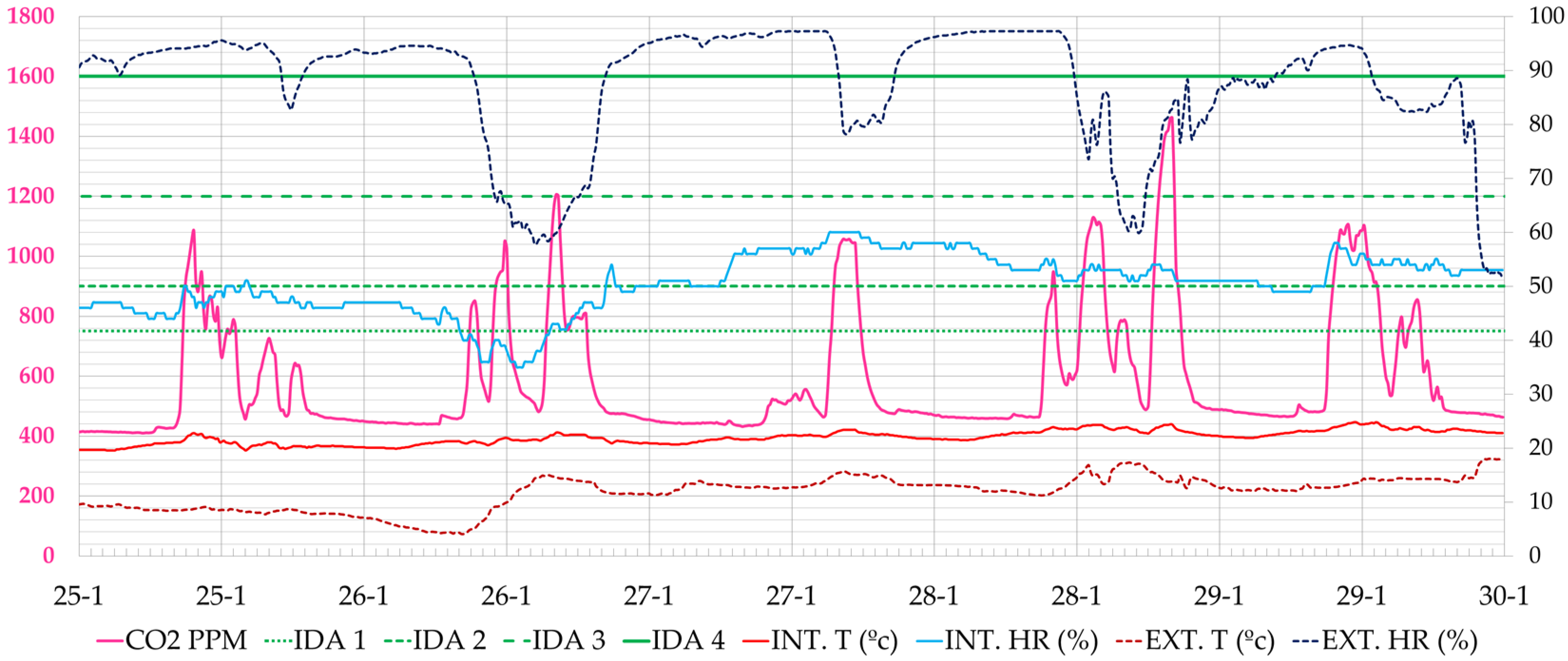

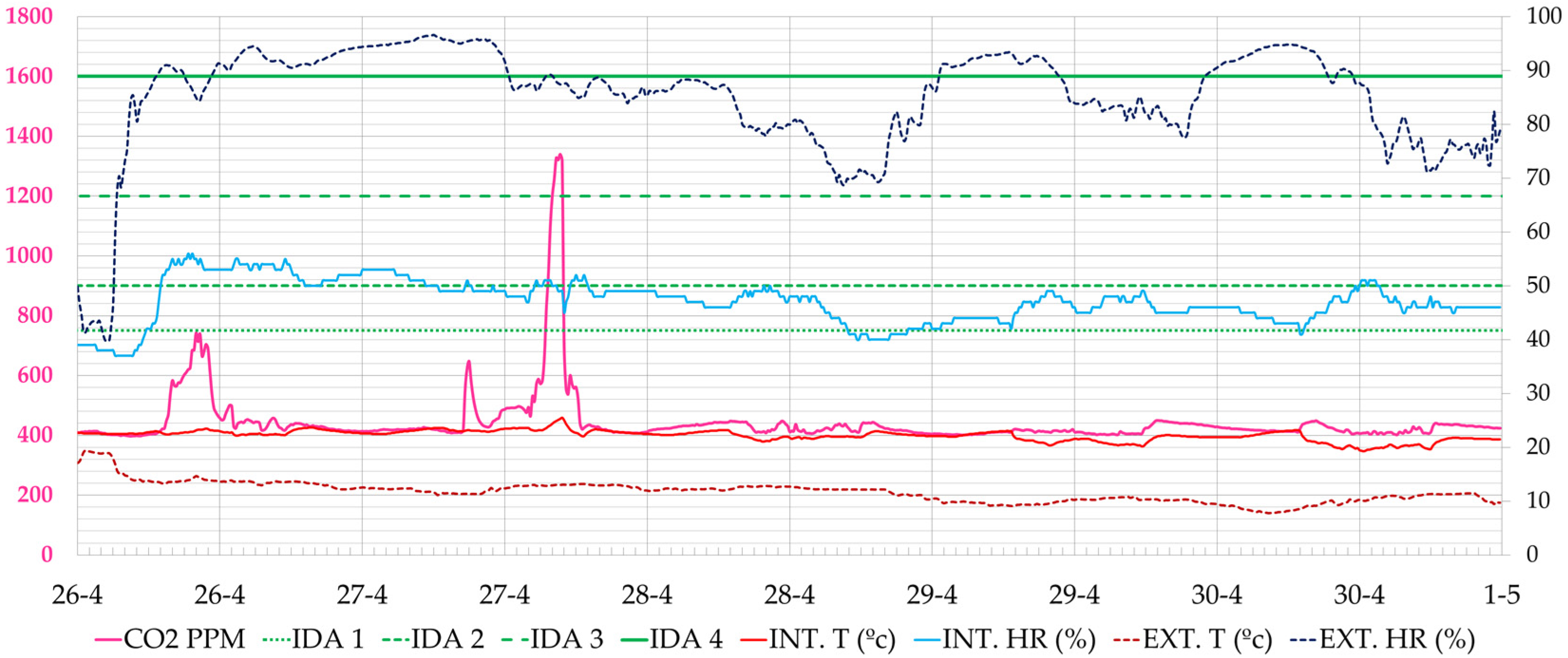

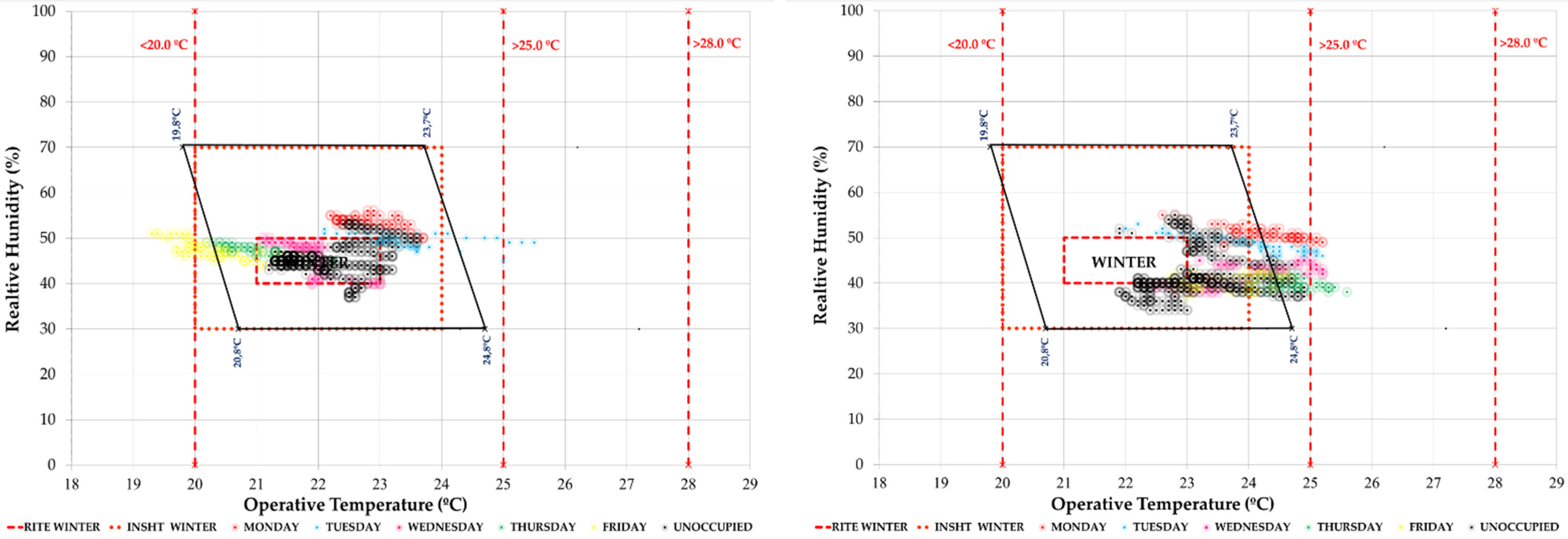
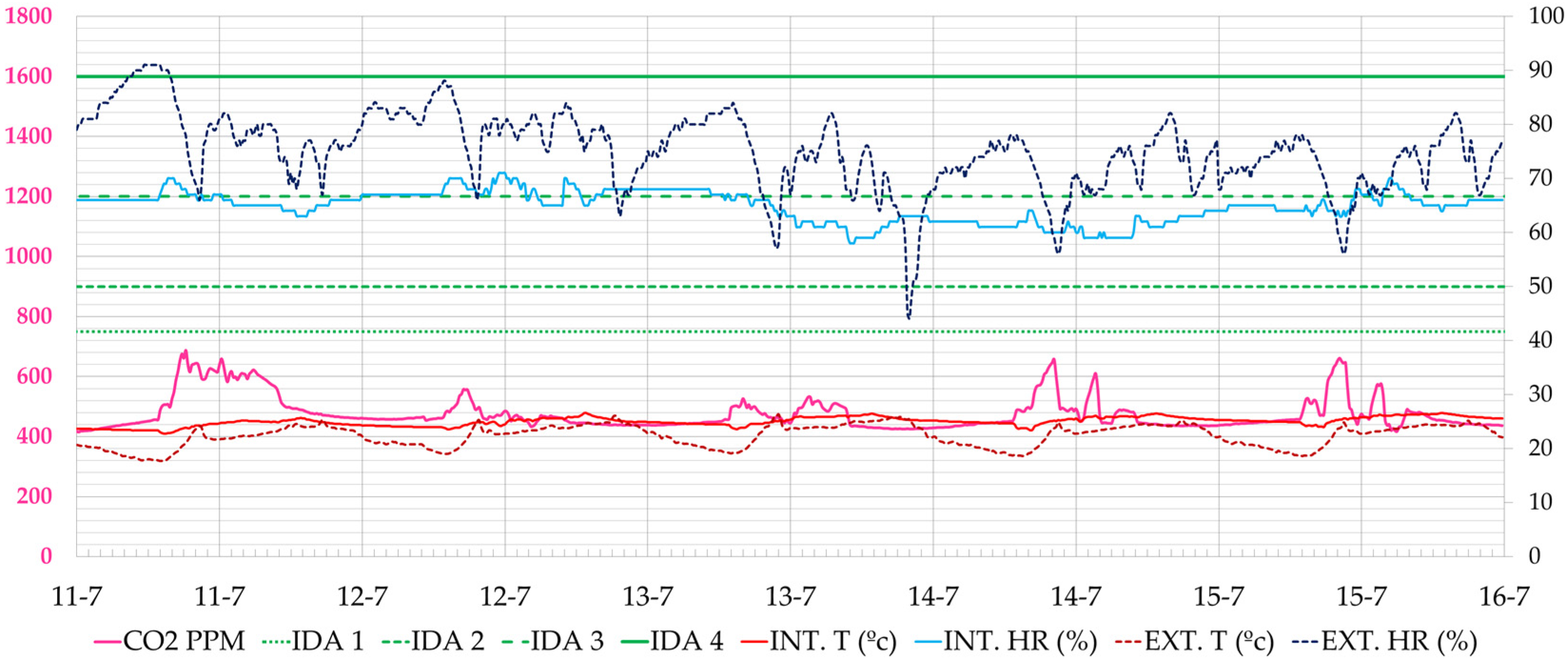

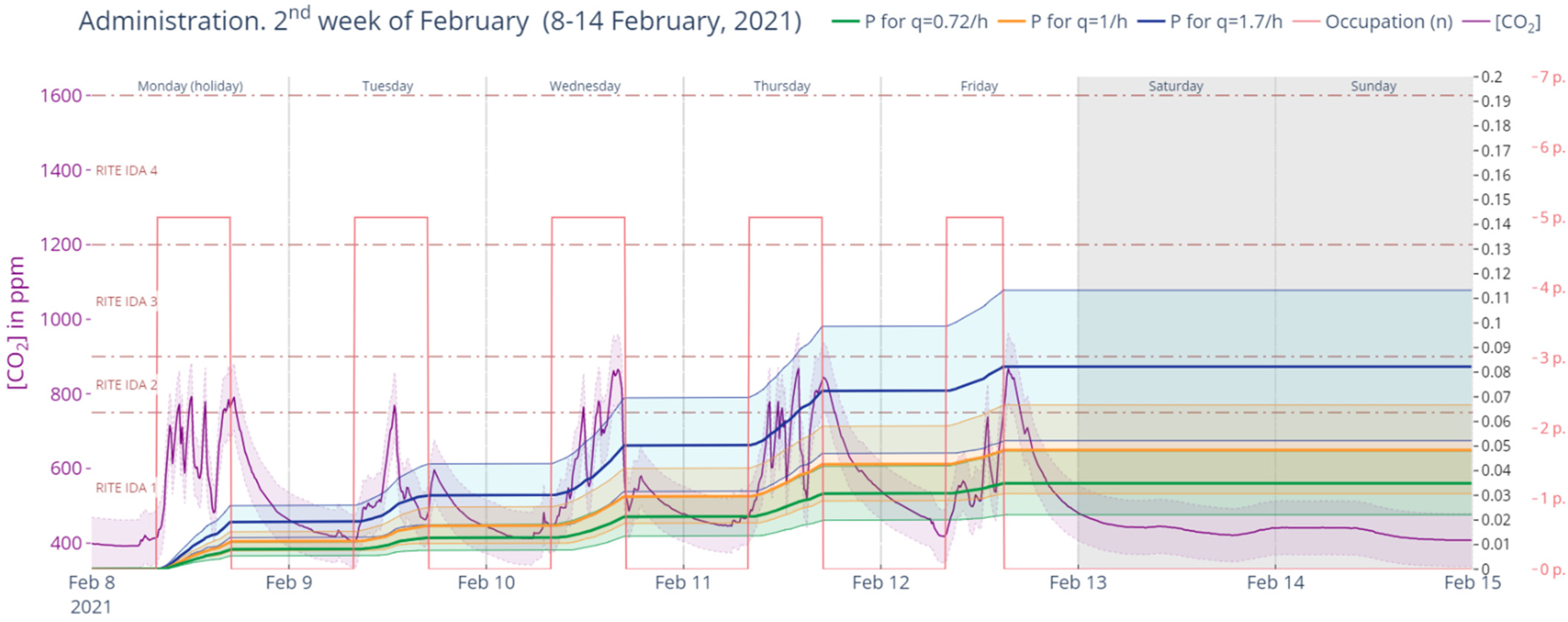

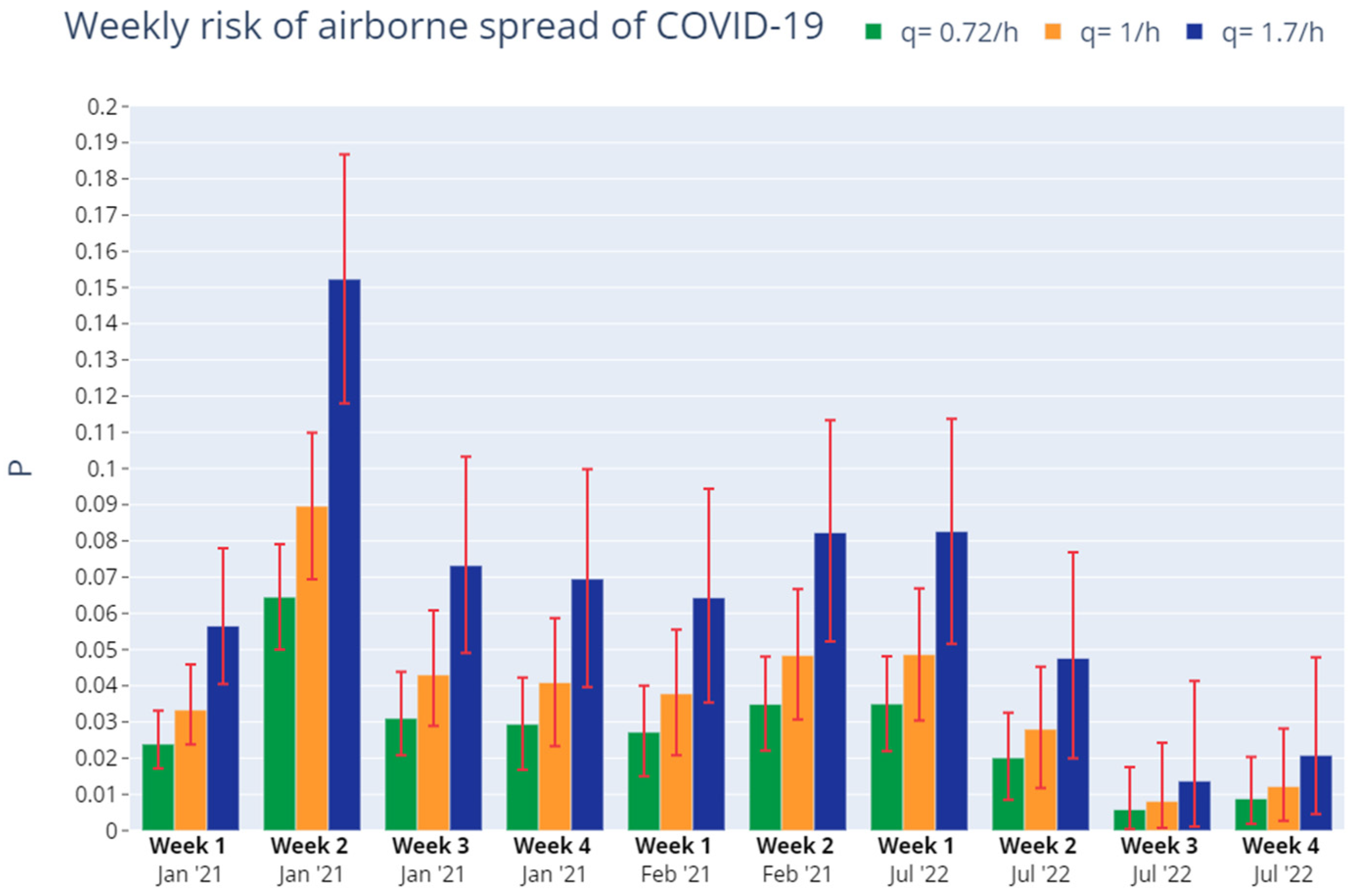
| Use | Surface | Volume | Max. Occ.1 | 50% Occ. 1 | OWA 2 | OWA/V 3 | |
|---|---|---|---|---|---|---|---|
| A 1.1 | classroom | 156.75 m2 | 603.50 m3 | 65 | 32 | 6.20 m2 | 0.0102 |
| A 2.1 | classroom | 114.75 m2 | 356.90 m3 | 48 | 24 | 8.20 m2 | 0.0229 |
| Admin. | office | 53.20 m2 | 164.90 m3 | 5 | - | 8.82 m2 | 0.0535 |
| EN 16798 | RITE | This Study | ||||
|---|---|---|---|---|---|---|
| Category | qv (l/s.p) | [CO2] Above Baseline | qv (l/s.p) | [CO2] Above Baseline | Selected Limit 1 | |
| Interval | Default | |||||
| Cat. I or IDA 1 | 20.0 | 550 | 20.0 | <400 | 350 | 750 |
| Cat. II or IDA 2 | 14.0 | 800 | 12.5 | 400–600 | 500 | 900 |
| Category III or IDA 3 | 8.0 | 1350 | 8.0 | 600–1000 | 800 | 1200 |
| Category IV or IDA 4 | - | - | - | >1000 | 1200 | 1600 |
| Analysis Periods | |||||||
| A 1.1 | A 2.1 | Administration Office | |||||
| Start | End | Start | End | Start | End | ||
| Phase I | 3 weeks | 30 November 2020 | 27 December 2020 | 30 November 2020 | 27 December 2020 | 4 January 2021 | 31 January 2021 |
| Phase II | (a) 3 weeks | 3 January 2021 | 14 February 2021 | 3 January 2021 | 14 February 2021 | 1 February 2021 | 14 February 2021 |
| (b) 1 week | 26 April 2021 | 4 May 2021 | 26 April 2021 | 4 May 2021 | - | - | |
| Phase III | 4 weeks | - | - | - | - | 4 July 2022 | 31 July 2022 |
| Analysis type | |||||||
| A 1.1 | A 2.1 | Administration office | |||||
| CO2 Concentration | Yes | Yes | Yes | ||||
| Winter Comfort | Yes | Yes | Yes | ||||
| Spring Comfort | Yes | Yes | No | ||||
| Summer Comfort | No | No | Yes | ||||
| Infection Risk | No | No | Yes | ||||
| Classroom A 1.1 | Classroom A 2.1 | |||||||||||
|---|---|---|---|---|---|---|---|---|---|---|---|---|
| Phase I | Phase II (a) | Phase II (b) | Phase I | Phase II (a) | Phase II (b) | |||||||
| Total analysed hours 1 | 180 h | 180 h | 60 h | 180 h | 180 h | 60 h | ||||||
| [CO2] | Minimum CO2 Concentration | 386 ppm | 403 ppm | • | 402 ppm | • | 396 ppm | 417 ppm | • | 406 ppm | • | |
| Maximum CO2 Concentration | 2738 ppm | 1580 ppm | • | 1339 ppm | • | 2181 ppm | 1457 ppm | • | 832 ppm | • | ||
| Average CO2 Concentration | 614 ppm | 674 ppm | • | 468 ppm | • | 642 ppm | 696 ppm | • | 581 ppm | • | ||
| RITE Air Quality | IDA 1 | Number of hours | 137 h | 121 h | 59 h | 131 h | 109 h | 53 h | ||||
| % hours | 76.1% | 67.2% | • | 98.3% | • | 72.8% | 60.6% | • | 88.3% | • | ||
| IDA 2 | Number of hours | 13 h | 24 h | 0 h | 30 h | 41 h | 7 h | |||||
| % hours | 7.2% | 13.3% | • | 0.0% | • | 16.7% | 22.7% | • | 11.7% | • | ||
| IDA 3 | Number of hours | 20 h | 26 h | 1 h | 16 h | 27 h | 0 h | |||||
| % hours | 11.1% | 14.4% | • | 1.7% | • | 26.7% | 15.0% | • | 0.0% | • | ||
| IDA 4 | Number of hours | 7 h | 9 h | 1 h | 1 h | 4 h | 0 h | |||||
| % hours | 3.9% | 5.0% | • | 1.7% | • | 0.6% | 2.2% | • | 0.0% | • | ||
| Temperature | Minimum T. | 15.6 °C | 17.6 °C | • | 19.3 °C | • | 16.8 °C | 19.6 °C | • | 22.0 °C | • | |
| Maximum T. | 22.5 °C | 26.1 °C | • | 25.5 °C | • | 21.8 °C | 25.1 °C | • | 25.6 °C | • | ||
| Relative Humidity | Minimum R.H. | 30% | 33% | • | 40% | • | 32% | 30% | • | 37% | • | |
| Maximum R.H. | 74% | 61% | • | 56% | • | 74% | 60% | • | 55% | • | ||
| Thermal Comfort | RITE 2 | Number of hours | 1 h | 39 h | 23 h | 12 h | 50 h | 2 h | ||||
| % hours | 0.5% | 21.7% | • | 38.3% | • | 6.7% | 27.8% | • | 3.3% | • | ||
| INSST 2 | Number of hours | 33 h | 142 h | 55 h | 77 h | 159 h | 24 h | |||||
| % hours | 18.3% | 78.9% | • | 91.7% | • | 42.8% | 88.3% | • | 40.0% | • | ||
| IAQ Compliance3 | Acceptable | Number of hours | 149 h | 145 h | 59 h | 161 h | 150 h | 60 h | ||||
| % hours | 82.8% | 80.6% | • | 98.3% | • | 89.4% | 83.3% | • | 100.0% | • | ||
| Unacceptable | Number of hours | 31 h | 35 h | 1 h | 19 h | 30 h | 0 h | |||||
| % hours | 17.2% | 19.4% | • | 1.7% | • | 10.6% | 16.7% | • | 0.0% | • | ||
| IEQ Compliance4 | Acceptable | Number of hours | 0 h | 35 h | 23 h | 9 h | 45 h | 2 h | ||||
| % hours | 0.0% | 19.4% | • | 38.3 % | • | 5.0% | 25.0% | • | 3.3% | • | ||
| Unacceptable | Number of hours | 180 h | 145 h | 37 h | 171 h | 135 h | 58 h | |||||
| % hours | 100% | 80.6% | • | 61.7% | • | 95.0% | 75.0% | • | 96.7% | • | ||
| Administration | |||||||
|---|---|---|---|---|---|---|---|
| Phase I | Phase II | Phase III | |||||
| Total analysed hours 1 | 129 h | 129 h | 105 h | ||||
| [CO2] | Minimum CO2 Concentration | 397 ppm | 411 ppm | • | 422 ppm | • | |
| Maximum CO2 Concentration | 1126 ppm | 869 ppm | • | 1141 ppm | • | ||
| Average CO2 Concentration | 581 ppm | 586 ppm | • | 536 ppm | • | ||
| RITE Air Quality | IDA 1 | Number of hours | 93 h | 115 h | 100 h | ||
| % hours | 72.1% | 89.1% | • | 95.2% | • | ||
| IDA 2 | Number of hours | 20 h | 14 h | 3 h | |||
| % hours | 15.5% | 10.9% | • | 2.9% | • | ||
| IDA 3 | Number of hours | 16 h | 0 h | 3 h | |||
| % hours | 12.4% | 0.0% | • | 2.9% | • | ||
| IDA 4 | Number of hours | 0 h | 0 h | 0 h | |||
| % hours | 0.0% | 0.0% | • | 0.0% | • | ||
| Temperature | Minimum T. | 10.9 °C | 10.6 °C | • | 21.5 °C | • | |
| Maximum T. | 22.9 °C | 23.6 °C | • | 26.3 °C | • | ||
| Relative Humidity | Minimum R.H. | 31% | 36% | • | 46% | • | |
| Maximum R.H. | 57% | 76% | • | 76% | • | ||
| Thermal Comfort | RITE 2 | Number of hours | 21 h | 40 h | 0 h | ||
| % hours | 16.3% | 31.0% | • | 0.0% | • | ||
| INSST 2 | Number of hours | 57 h | 99 h | 72 h | |||
| % hours | 44.2% | 76.7% | • | 68.6% | • | ||
| IAQ Compliance3 | Acceptable | Number of hours | 113 h | 129 h | 103 h | ||
| % hours | 87.6% | 100.0% | • | 98.1% | • | ||
| Unacceptable | Number of hours | 16 h | 0 h | 2 h | • | ||
| % hours | 12.4% | 0.0% | • | 1.9% | |||
| IEQ Compliance4 | Acceptable | Number of hours | 15 h | 53 h | 0 h | ||
| % hours | 11.6% | 41.1% | • | 0.0 % | • | ||
| Unacceptable | Number of hours | 114 h | 76 h | 105 h | |||
| % hours | 88.4% | 59.9% | • | 100.0% | • | ||
| CO2 Concentration | f | f (%) | |
|---|---|---|---|
| Recorded minimum | 386 ppm | 0.0000 | 0.00% |
| Assumed outdoor baseline | 400 ppm | 0.0000 | 0.00% |
| 600 ppm | 0.0053 | 0.53% | |
| IDA 1 limit | 750 ppm | 0.0079 | 0.79% |
| 800 ppm | 0.0092 | 0.92% | |
| IDA 2 limit | 900 ppm | 0.0105 | 1.05% |
| 1000 ppm | 0.0132 | 1.32% | |
| IDA 3 limit | 1200 ppm | 0.0158 | 1.58% |
| IDA 3 limit | 1600 ppm | 0.0211 | 2.11% |
| 2000 ppm | 0.0289 | 2.89% | |
| Recorded maximum | 2738 ppm | 0.0615 | 6.15% |
| Title 2 | P for 0.72 q/h | P for 1.00 q/h | P for 1.70 q/h | |||||
|---|---|---|---|---|---|---|---|---|
| Phase I | 4–10 January | 2021 | 0.0239 | +0.0092 −0.0067 | 0.0333 | +0.0126 −0.0095 | 0.0565 | +0.0215 −0.0160 |
| 11–17 January | 2021 | 0.0645 | +0.0146 −0.0145 | 0.0896 | +0.0203 −0.0202 | 0.1523 | +0.0345 −0.0343 | |
| 18–24 January | 2021 | 0.0310 | +0.0128 −0.0102 | 0.0430 | +0.0178 −0.0141 | 0.0732 | +0.0301 −0.0241 | |
| Phase II | 25–31 January | 2021 | 0.0294 | +0.0129 −0.0126 | 0.0409 | +0.0178 −0.0176 | 0.0695 | +0.0303 −0.0299 |
| 1–7 February | 2021 | 0.0272 | +0.0128 −0.0122 | 0.0378 | +0.0177 −0.0170 | 0.0643 | +0.0301 −0.0289 | |
| 8–14 February | 2021 | 0.0349 | +0.0131 −0.0128 | 0.0484 | +0.0183 −0.0177 | 0.0823 | +0.0310 −0.0301 | |
| Phase III | 4–10 July | 2022 | 0.0350 | +0.0131 −0.0131 | 0.0486 | +0.0183 −0.0182 | 0.0826 | +0.0310 −0.0310 |
| 11–17 July | 2022 | 0.0201 | +0.0125 −0.0116 | 0.0280 | +0.0172 −0.0162 | 0.1523 | +0.0293 −0.0272 | |
| 18–24 July | 2022 | 0.0058 | +0.0117 −0.0053 | 0.0081 | +0.0162 −0.0074 | 0.0137 | +0.0276 −0.0126 | |
| 25–31 July | 2022 | 0.0088 | +0.0115 −0.0069 | 0.0122 | +0.0160 −0.0095 | 0.0208 | +0.0271 −0.0162 | |
Publisher’s Note: MDPI stays neutral with regard to jurisdictional claims in published maps and institutional affiliations. |
© 2022 by the authors. Licensee MDPI, Basel, Switzerland. This article is an open access article distributed under the terms and conditions of the Creative Commons Attribution (CC BY) license (https://creativecommons.org/licenses/by/4.0/).
Share and Cite
Rodríguez-Vidal, I.; Martín-Garín, A.; González-Quintial, F.; Rico-Martínez, J.M.; Hernández-Minguillón, R.J.; Otaegi, J. Response to the COVID-19 Pandemic in Classrooms at the University of the Basque Country through a User-Informed Natural Ventilation Demonstrator. Int. J. Environ. Res. Public Health 2022, 19, 14560. https://doi.org/10.3390/ijerph192114560
Rodríguez-Vidal I, Martín-Garín A, González-Quintial F, Rico-Martínez JM, Hernández-Minguillón RJ, Otaegi J. Response to the COVID-19 Pandemic in Classrooms at the University of the Basque Country through a User-Informed Natural Ventilation Demonstrator. International Journal of Environmental Research and Public Health. 2022; 19(21):14560. https://doi.org/10.3390/ijerph192114560
Chicago/Turabian StyleRodríguez-Vidal, Iñigo, Alexander Martín-Garín, Francisco González-Quintial, José Miguel Rico-Martínez, Rufino J. Hernández-Minguillón, and Jorge Otaegi. 2022. "Response to the COVID-19 Pandemic in Classrooms at the University of the Basque Country through a User-Informed Natural Ventilation Demonstrator" International Journal of Environmental Research and Public Health 19, no. 21: 14560. https://doi.org/10.3390/ijerph192114560
APA StyleRodríguez-Vidal, I., Martín-Garín, A., González-Quintial, F., Rico-Martínez, J. M., Hernández-Minguillón, R. J., & Otaegi, J. (2022). Response to the COVID-19 Pandemic in Classrooms at the University of the Basque Country through a User-Informed Natural Ventilation Demonstrator. International Journal of Environmental Research and Public Health, 19(21), 14560. https://doi.org/10.3390/ijerph192114560












